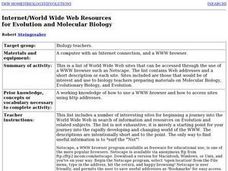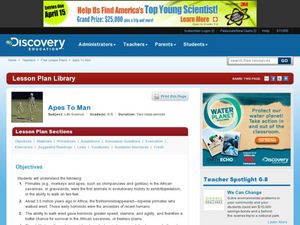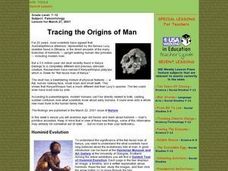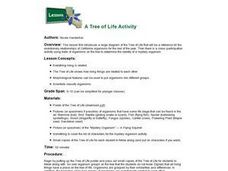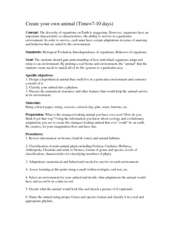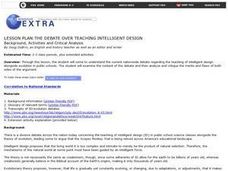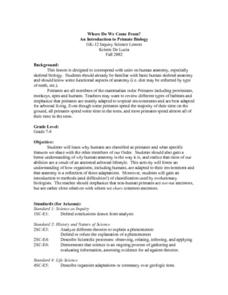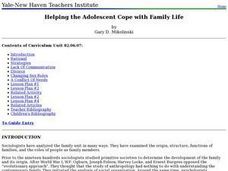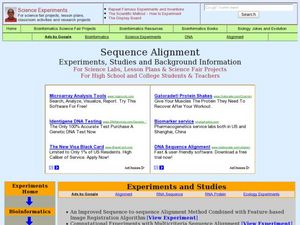Curated OER
Internet/World Wide Web Resources for Evolution and Molecular Biology
Students utilize the Internet and all its web access in this lesson. They research all they can on Evolution and related subjects. The journey they begin on leads them into an exhaustible point of possibilities for Evolution and all its...
Curated OER
Apes To Man
Students study primates and their evolution history. In this role play instructional activity students view a video on evolution then demonstrate how primates walked and other observations they noticed in the film.
Curated OER
How Does Evolution Work?
Students pretend they are a scientist like John Endler in this Web activity. They visit his pools, from hypotheses, and test them out. In the process, the explore about natural selection and sexual selection. They are able to explain the...
Curated OER
Tracing the Origins of Man
Learners discuss Hominid evolution through various websites and other resources. They examine online fossil skulls, discuss the use of tools by ancient man, and look for examples of sophisticated tools built by man.
Curated OER
Time Conceptualization
Students relate the number and length of generations in their living family members to the number of generations that have passed since specific events in recorded history. They then apply this time conceptualization to the number of...
Curated OER
A Tree of Life Activity
Learners solve a mystery of the identification of a unknown organism by comparing its morphological characteristics to those in a tree of life classification poster. They compare the observable characteristics of the specimen and...
Curated OER
Create Your Own Animal
Students design and create their own hypothetical animal. In this biology lesson, students identify the factors organisms need to survive. They classify their animals according to its correct phylum.
Curated OER
It's All In The Rocks
Learners think critically to determine fact or inference when examining sedimentary layers with embedded fossils. Geology and evolutionary biology are introduced. They individually write a story about various diagrams and share their...
Curated OER
Thanksgiving: Bird Evolution
Students explore the evolution of birds. In this biology lesson plan, students research articles that discuss evidence about the ancestry of birds. They discuss their findings with the group and draw a journal magazine cover highlighting...
Curated OER
Primate Characteristics and Exaptation
High schoolers compare the features of gorilla to humans. For this biology lesson, students simulate adaptation using materials found in the classroom. They explain what exaptation means.
Curated OER
Molecular Approaches to Evolution
High schoolers are introduced to working with molecular data. The first activity does both simulated and original data are used to compare amino acid, protein or DNA differences to construct phylogenetic trees or cladograms. These...
Curated OER
Bermuda: Search for Deep Water Caves 2009: Out of Darkness
Learners analyze the three models on the origin of troglobitic fauna. In this life science lesson, students also consider how the Zonation model explains the fauna's origin. They also use the Internet to research solutional and volcanic...
Curated OER
Pangaea Puzzle: Exploring the Tectonic Forces That Shape the Earth
Sixth graders follow in the footsteps of early scientists as they put the pieces of Pangaea back together and discovered the forces that create the variety of landforms and sea-floor features of our Earth.
Curated OER
The Debate Over Teaching Intelligent Design
Students explain the current nationwide debate regarding the teaching of intelligent design alongside evolution in public schools. They examine the content of the debate and then analyze and critique the merits and flaws of both sides of...
Curated OER
Social Change and Modernization
In this social change and modernization worksheet, students respond to 6 short answer questions and answer 6 multiple choice questions regarding these sociology topics.
Curated OER
Candy Dish Selection
High schoolers explore natural selection. They explore the concepts of adaptations, and the way which random factors affect the survival of individuals and populations.
Curated OER
Natural Selection Foldable
Students examine and identify examples of species that developed as a result of immigration, genetic drift, and adaptive radiation. They conduct Internet research and define key vocabulary terms, and use their species example on their...
Curated OER
Where Do We Come From? An Introduction to Primate Biology
Seventh graders explore skeletal biology. Through a discussion and video observation, 7th graders investigate how the anatomy is adapted to the environment. Students study primates and explore their characteristics and behaviors.
Curated OER
Helping the Adolescent Cope with Family Life
Students are introduced to the proper ways to deal with conflict at home. In groups, they define family based on what it means to them and identify factors that lead to a breakdown in communications. They participate in role-playing...
Curated OER
From Wolf to Dog
Students explain how dogs evolved from wolves based on the video. In this biology lesson, students research about breeding animals for specific traits. They interview dog owners and create a presentation about the dog.
Curated OER
Learning Cycle Lesson Plan #6 (Misconception)
Ninth graders investigate evolution via natural selection and form an opinion. They support their opinion using scientific evidence and apply this to adaptations that have allowed certain organisms to survive.
Curated OER
Sequence Alignment
Students explore the uses of sequence alignment. For this DNA lesson students complete several experiments on sequencing and algorithms.
Curated OER
Human Evolution
Students make and use observations of Laetoli footprints to provide clues to life in the past. They collect and analyze data to study the relationship between foot length and body height.
Curated OER
How Science Works: Natural Selection
Students are introduced to the topic of adaptation and discuss how various animals adapt to their environment. In groups, they participate in a simulation in which they are selected based on criteria. They discuss the results and relate...
